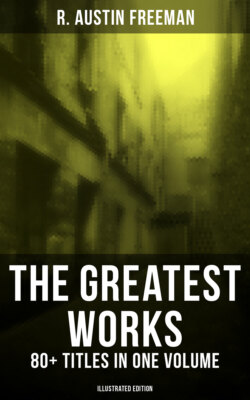Читать книгу The Greatest Works of R. Austin Freeman: 80+ Titles in One Volume (Illustrated Edition) - R. Austin Freeman - Страница 4
На сайте Литреса книга снята с продажи.
SHORT BIOGRAPHY
ОглавлениеTable of Contents
Richard Austin Freeman (11 April 1862 – 28 September 1943) was a British writer of detective stories, mostly featuring the medico-legal forensic investigator Dr. Thorndyke. He claimed to have invented the inverted detective story (a crime fiction in which the commission of the crime is described at the beginning, usually including the identity of the perpetrator, with the story then describing the detective's attempt to solve the mystery). Freeman used some of his early experiences as a colonial surgeon in his novels. Many of the Dr. Thorndyke stories involve genuine, but often quite arcane, points of scientific knowledge, from areas such as tropical medicine, metallurgy and toxicology.
Early life
Austin Freeman was the youngest of the five children of tailor Richard Freeman and Ann Maria Dunn. He first trained as an apothecary and then studied medicine at Middlesex Hospital, qualifying in 1887. The same year he married Annie Elizabeth, with whom he had two sons. He entered the Colonial Service and was sent to Accra on the Gold Coast.
Career
In 1891 he returned to London after suffering from blackwater fever but was unable to find a permanent medical position, and so decided to settle down in Gravesend and earn money from writing fiction, while continuing to practice medicine. His first stories were written in collaboration with John James Pitcairn (1860–1936), medical officer at Holloway Prison, and published under the nom de plume "Clifford Ashdown". His first Thorndyke story, The Red Thumb Mark, was published in 1907, and shortly afterwards he pioneered the inverted detective story, in which the identity of the criminal is shown from the beginning. Some short stories with this feature were collected in The Singing Bone in 1912. During the First World War he served as a captain in the Royal Army Medical Corps and afterwards produced a Thorndyke novel almost every year until his death in 1943.
Freeman claimed to have invented the inverted detective story in his 1912 collection of short stories The Singing Bone. "Some years ago I devised, as an experiment, an inverted detective story in two parts. The first part was a minute and detailed description of a crime, setting forth the antecedents, motives, and all attendant circumstances. The reader had seen the crime committed, knew all about the criminal, and was in possession of all the facts. It would have seemed that there was nothing left to tell, but I calculated that the reader would be so occupied with the crime that he would overlook the evidence. And so it turned out. The second part, which described the investigation of the crime, had to most readers the effect of new matter."
Political Views
Freeman held conservative political views. In his 1921 book Social Decay and Regeneration Freeman put forth the view that mechanization had flooded Britain with poor-quality goods and created a "homogenized, restless, unionized working class". Freeman also supported some progressive ideas, such as the eugenics movement and argued with Margaret Sanger that people with "undesirable" biological traits should be prevented from breeding through "segregation, marriage restriction, and sterilization". The book also attacked the British Labour movement and criticized the British government for permitting immigrants (whom Freeman referred to as "Sub-Man") to settle in Britain. Sections of Social Decay and Regeneration were reprinted in Eugenics Review, the journal of the British Eugenics Society.
Critical Reception
"Indicative of his power is the fact that Mr. Polton Explains, in some ways his best novel, was written in part in a bomb shelter in 1939, when Freeman was 77 years old. ... For the first twenty-five years of his career, at least, he dominated the world of British detective fiction. ... Freeman was always in the forefront of the form. Today, with Chesterton, who is remembered for other reasons, he is one of the very few Edwardian detective story writers who are still read."
"Raymond Chandler, whose essay 'The Simple Art of Murder' did much toward demolishing the classical detective story, had this to say in a letter to Hamish Hamilton, the British publisher: 'This man Austin Freeman is a wonderful performer. He has no equal in his genre, and he is also a much better writer than you might think, if you were superficially inclined, because in spite of the immense leisure of his writing, he accomplishes an even suspense which is quite unexpected ... There is even a gaslight charm about his Victorian love affairs, and those wonderful walks across London ...' Most of us agree with Chandler."
| This text is based on the Wikipedia article R. Austin Freeman: https://en.wikipedia.org/wiki/R._Austin_Freeman which is released under the Creative Commons Attribution-ShareAlike 3.0 Unported License available online at: http://creativecommons.org/licenses/by-sa/3.0/legalcode List of authors: https://tools.wmflabs.org/xtools/wikihistory/wh.php?page_title=R._Austin_Freeman |
